NEETS Module 5 - Introduction to Generators and Motors
Pages i,
1-1,
1-11,
1-21,
1-31,
2-1,
2-11,
3-1,
3-11,
4-1,
4-11, Index
The interpole coil in a
motor is connected to carry the armature current the same as in a generator. As the load varies, the interpole
flux varies, and commutation is automatically corrected as the load changes. It is not necessary to shift the
brushes when there is an increase or decrease in load. The brushes are located on the no-load neutral plane. They
remain in that position for all conditions of load. Q15. What current flows in the interpole windings?
The DC motor is reversed by reversing the direction of the current in the armature. When the armature current is
reversed, the current through the interpole is also reversed. Therefore, the interpole still has the proper
polarity to provide automatic commutation.
MANUAL and AUTOMATIC STARTERS Because the DC resistance of most motor armatures is low (0.05 to 0.5 ohm), and because the counter EMF
does not exist until the armature begins to turn, it is necessary to use an external starting resistance in series
with the armature of a DC motor to keep the initial armature current to a safe value. As the armature begins to
turn, counter EMF increases; and, since the counter EMF opposes the applied voltage, the armature current is
reduced. The external resistance in series with the armature is decreased or eliminated as the motor comes up to
normal speed and full voltage is applied across the armature. Controlling the starting resistance in a DC
motor is accomplished either manually, by an operator, or by any of several automatic devices. The automatic
devices are usually just switches controlled by motor speed sensors. Automatic starters are not covered in detail
in this module. Q16. What is the purpose of starting resistors?
Summary This chapter presented the operating principles and characteristics of direct-current motors. The
following information provides a summary of the main subjects for review. The main PRINCIPLE of a
DC MOTOR
is that current flow through the armature coil causes the armature to act as a magnet. The armature poles are
attracted to field poles of opposite polarity, causing the armature to rotate. The CONSTRUCTION
of a DC motor is almost identical to that of a DC generator, both physically and electrically. In fact, most DC
generators can be made to act as DC motors, and vice versa. COMMUTATION IN a DC MOTOR is
the process of reversing armature current at the moment when unlike poles of the armature and field are facing
each other, thereby reversing the polarity of the armature field. Like poles of the armature and field then repel
each other, causing armature rotation to continue.
2-11
 COUNTER-ELECTROMOTIVE forCE is generated in a DC motor as armature coils cut the field
flux. This EMF opposes the applied voltage, and limits the flow of armature current. In Series
MOTORS, the field windings are connected in series with the armature coil. The field strength varies with
changes in armature current. When its speed is reduced by a load, the series motor develops greater torque. Its
starting torque is greater than other types of DC motors. Its speed varies widely between full-load and no-load.
Unloaded operation of large machines is dangerous.
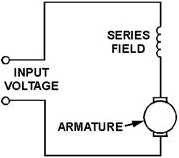
In Shunt MOTORS, the field windings are connected in parallel (shunt) across the
armature coil. The field strength is independent of the armature current. Shunt-motor speed varies only slightly
with changes in load, and the starting torque is less than that of other types of DC motors.
2-12
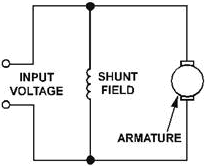
In COMPOUND MOTORS, one set of field windings is connected in series with the armature,
and one set is connected in parallel. The speed and torque characteristics are a combination of the desirable
characteristics of both series and shunt motors.
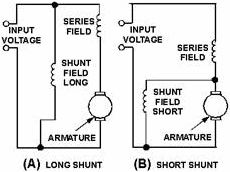
Load on a motor is the physical object to be moved by the motor.
DC MOTOR ARMATURES are of two types. They are the Gramme-ring and the drum-wound types.
The GRAMME-RING ARMATURE is inefficient since part of each armature coil is prevented from
cutting flux lines. Gramme-ring wound armatures are seldom used for this reason.
2-13
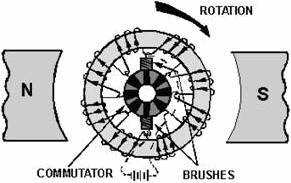 The DRUM-WOUND ARMATURE consists of coils actually wound around the armature core so
that all coil surfaces are exposed to the magnetic field. Nearly all DC motors have drum-wound armatures.
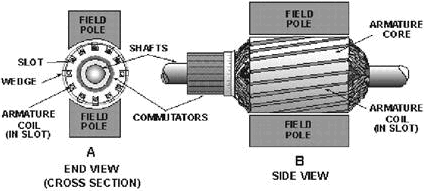 MOTOR REVERSAL in a DC motor can be accomplished by reversing the field connections or
by reversing the armature connections. If both are reversed, rotation will continue in the original direction.
SPEED CONTROL IN a DC MOTOR is maintained by varying the resistance either in series with the
field coil or in series with the armature coil. Increasing shunt-field circuit resistance increases motor speed.
Increasing the armature circuit resistance decreases motor speed.
2-14
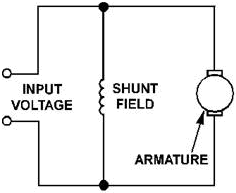 ARMATURE REACTION is the distortion of the main field in a motor by the armature field.
This causes the neutral plane to be shifted in the direction opposite to that of armature rotation. Interpoles and
compensating windings are used to reduce the effect of armature reaction on motor operation.
STARTING ResistorS are necessary since the DC resistance of a motor armature is very low. Excessive
current will flow when DC voltage is first applied unless current is limited in some way. Adding resistance in
series with the armature windings reduces initial current. It may then be removed after counter EMF has been built
up. Answers to Questions Q1. Through Q16. A1. Direction of armature current, and direction of magnetic flux in field.
A2. Direction of conductor movement (rotation), direction of flux, and the direction of current flow.
A3. There are no differences. A4. Generator action. A5. Speed. A6. The
device to be driven by the motor. A7. It must have a load connected to avoid damage from excess speed.
A8. High torque (turning force) at low speed. A9. It maintains a constant speed under varying
loads. A10. Only outside of coils cut flux (inefficient).
A11. By winding the armature in a way that places the entire coil where it is exposed to maximum flux.
A12. By reversing either field or armature connections.
2-15
A13. Motor will slow down. A14. Opposite the rotation. A15. Armature current.
A16. To limit armature current until counter EMF builds up.
2-16
| - |
Matter, Energy,
and Direct Current |
| - |
Alternating Current and Transformers |
| - |
Circuit Protection, Control, and Measurement |
| - |
Electrical Conductors, Wiring Techniques,
and Schematic Reading |
| - |
Generators and Motors |
| - |
Electronic Emission, Tubes, and Power Supplies |
| - |
Solid-State Devices and Power Supplies |
| - |
Amplifiers |
| - |
Wave-Generation and Wave-Shaping Circuits |
| - |
Wave Propagation, Transmission Lines, and
Antennas |
| - |
Microwave Principles |
| - |
Modulation Principles |
| - |
Introduction to Number Systems and Logic Circuits |
| - |
- Introduction to Microelectronics |
| - |
Principles of Synchros, Servos, and Gyros |
| - |
Introduction to Test Equipment |
| - |
Radio-Frequency Communications Principles |
| - |
Radar Principles |
| - |
The Technician's Handbook, Master Glossary |
| - |
Test Methods and Practices |
| - |
Introduction to Digital Computers |
| - |
Magnetic Recording |
| - |
Introduction to Fiber Optics |
| Note: Navy Electricity and Electronics Training
Series (NEETS) content is U.S. Navy property in the public domain. |
|














